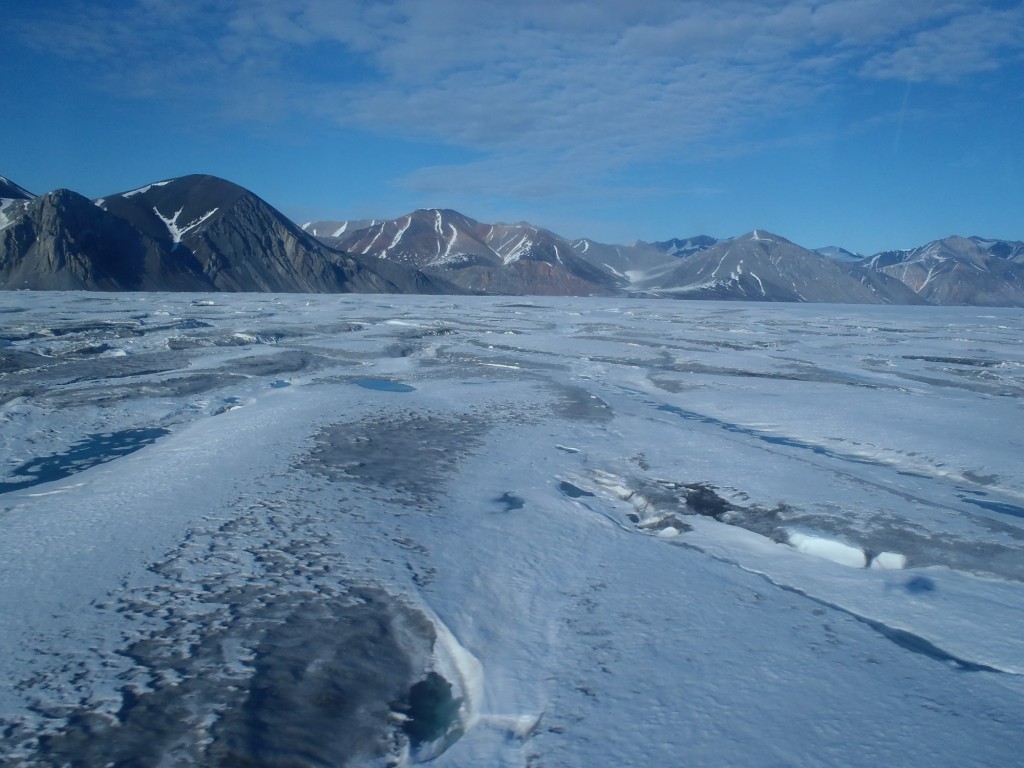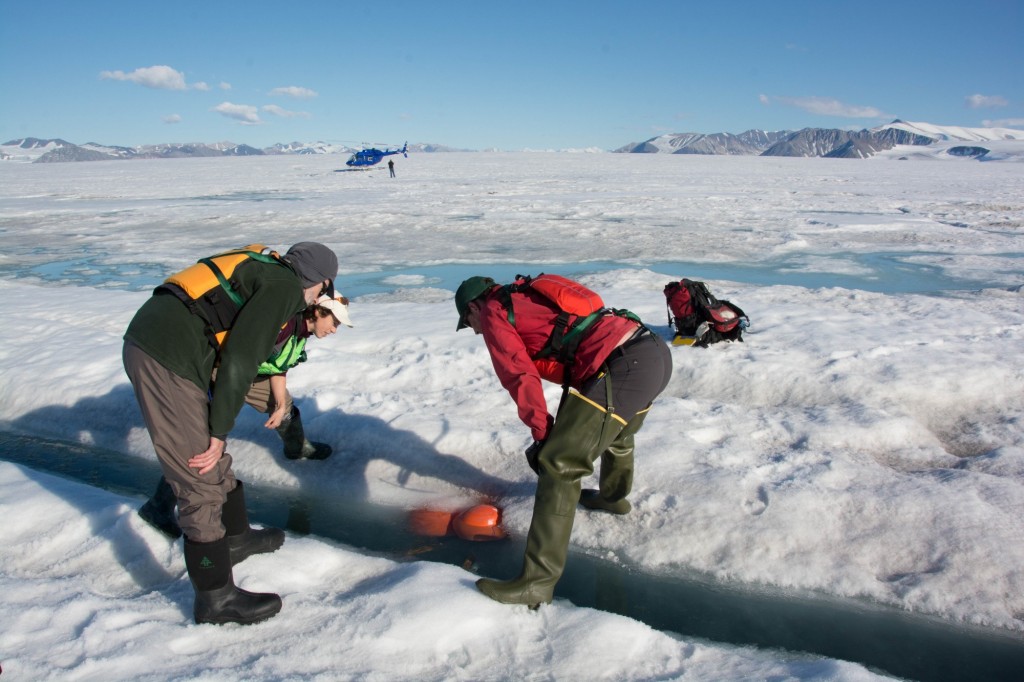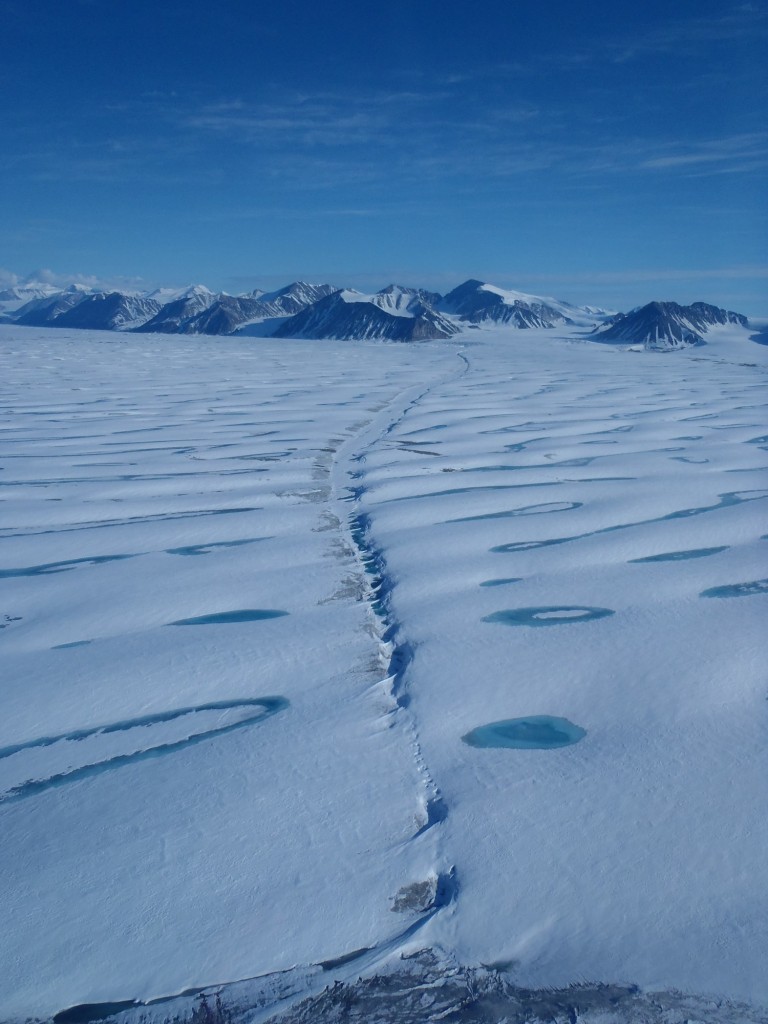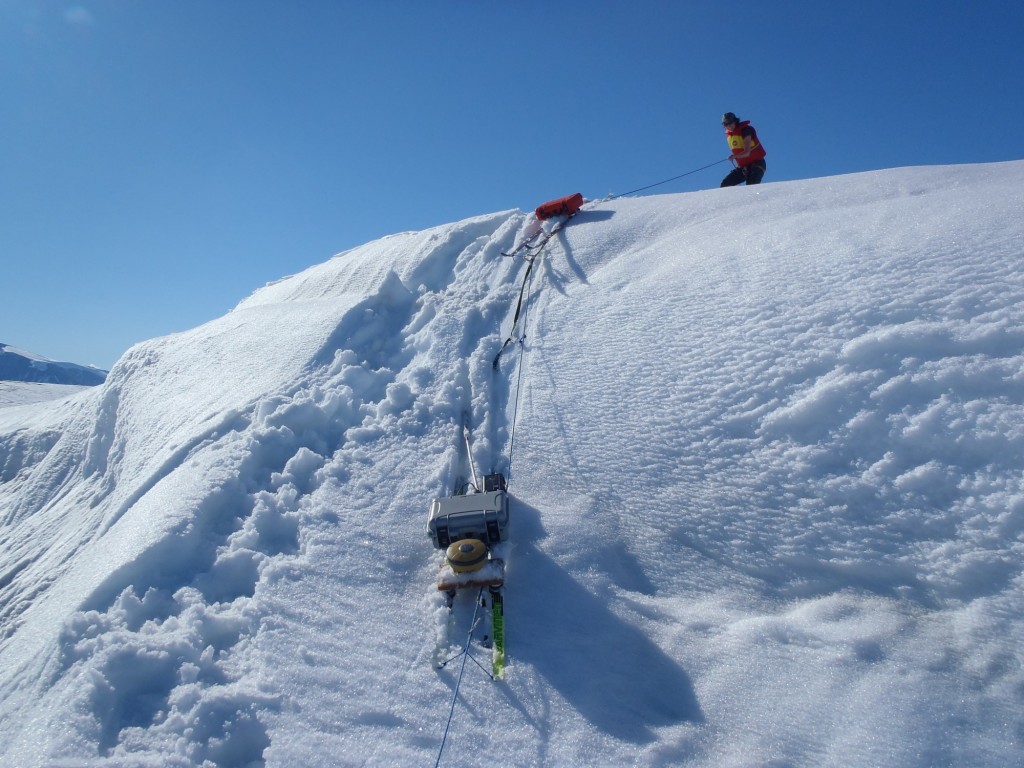Milne Ice Shelf
WIRL researchers and collaborators have been studying the Milne Ice Shelf since 2008, travelling over the ice shelf by snowmobile, on foot, and by helicopter to collect data. The Milne Ice Shelf was 187 km2 in 2015 and is located within Milne Fiord (82°35’N 80°35’W), between Cape Evans and Cape Egerton. It has a mean thickness of 55 m, with a maximum thickness of 94 m. The ice shelf is composed of both glacier and sea ice, and glaciers along the fiord walls still provide a small amount of ongoing glacial input. In comparison to the other ice shelves along the northern coast of Ellesmere Island, the Milne Ice Shelf has remained relatively intact over the course of the last century, but calved substantially in late July 2020. As a result, this ice shelf dams what is likely the last remaining epishelf lake in Canada. The Milne Ice Shelf therefore represents the final opportunity to study an ice shelf-epishelf lake system in the Canadian Arctic; it is a valuable laboratory for investigation into the processes and interactions at work in such a system. Work on the Milne Ice Shelf by WIRL researchers has focused both on monitoring and quantifying change on the ice shelf, as well as examining mechanisms driving change.
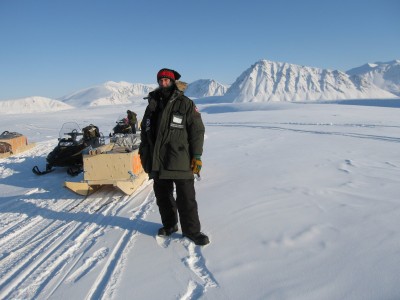
One of our first trips to Milne Fiord was in 2008 with the Canadian Rangers (J. Lewis)
Repeat measurements of ice thickness, the first direct measurements of thickness change for any northern Ellesmere Island ice shelf, revealed that the Milne Ice Shelf thinned by an average of 8.1±2.8 m from 1981-2009. WIRL researchers and collaborators have also been monitoring surface melt on the ice shelf since 2008. Analysis of changes in ice shelf extent over time also revealed that the Milne Ice Shelf was reduced in area by 30% from 1950 to 2009. Together, these data suggest the ice shelf is in a state of negative mass balance (more mass is being lost via surface melt and/or melt at the base of the ice shelf and through calving than is being gained by the accumulation of snow and ice onto the ice shelf).
Another focus of research on the ice shelf is understanding what is happening beneath the ice shelf, at the ice-ocean interface. Little is known about sub-ice shelf processes, because of the difficulty of accessing the ocean through ice that is tens of meters thick.
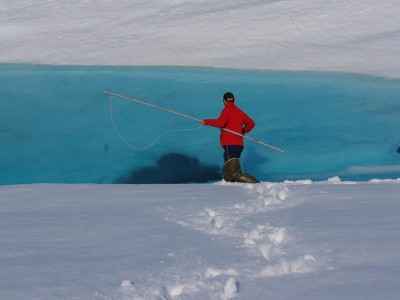
Derek probes the bottom of a pond to see if we can get instruments through (A. Hamilton)
However, recently, WIRL researchers discovered that (relatively) warm freshwater draining out to the Arctic Ocean beneath the ice shelf from the Milne Fiord epishelf lake has melted a deep channel upward into the base of the ice shelf. The channel was mapped using ice penetrating radar to examine the basal topography of the ice shelf. Holes were also drilled right through the ice shelf, using a steam drill, allowing the team to deploy instruments to measure the temperature and salinity of the water in the channel, as well as flow speed of epishelf lake water through this conduit. Radar mapping revealed that, in some locations along the channel’s length, the ice shelf is as little as 5-10 m thick. The presence of such thin ice along the channel represents a significant structural weakness in the ice shelf, making the ice shelf vulnerable to fracturing along this channel.
Resources:
Hamilton AK (2016) Ice-ocean interactions in Milne Fiord. PhD Dissertation, University of British Columbia, Department of Civil Engineering URL: http://hdl.handle.net/2429/59051
Hamilton AK, Laval BE, Mueller DR, et al (2017) Dynamic response of an Arctic epishelf lake to seasonal and long-term forcing: implications for ice shelf thickness. The Cryosphere Discussions 2017:1–34. doi: 10.5194/tc-2017-19
Jeffries MO (1986a) Glaciers and the morphology and structure of the Milne Ice Shelf, Ellesmere Island, N.W.T., Canada. Arct Alp Res 18:397–405. doi: 10.2307/1551089
Jeffries MO (1986b) Ice island calvings and ice shelf changes, Milne Ice Shelf and Ayles Ice Shelf, Ellesmere Island, N.W.T. Arctic 39:15–19. doi: 10.14430/arctic2039
Mortimer CA, Copland L, Mueller DR (2012) Volume and area changes of the Milne Ice Shelf, Ellesmere Island, Nunavut, Canada, since 1950. J Geophys Res 117:F04011. doi: 10.1029/2011JF002074
Mueller D, Copland L and Jeffries MO (2017) Changes in Canadian Arctic ice shelf extent since 1906. Copland L and Mueller D eds. Arctic Ice Shelves and Ice Islands. Springer, Dordrecht, 109–148 10.1007/978-94-024-1101-0_5
Rajewicz J (2017) Channelized Epishelf Lake Drainage Beneath the Milne Ice Shelf, Ellesmere Island, Nunavut. MSc thesis, Carleton University, Department of Geography and Environmental Studies 10.22215/etd/2017-11860
Our work on the Milne Ice Shelf was made possible through in-kind support from Polar Shelf, along with financial support from ArcticNet, NSERC, NSTP, and the Canada Foundation for Innovation.
- The Milne Ice Shelf is very thin and dirty near the epishelf lake to the south. (D.Mueller)
- Looking for instruments that were deployed a year ago through the ice shelf (A. Garbo)
- A fracture that opened between 2008 and 2009 (D. Mueller)
- Carefully lowering an ice penetrating radar system on the Mlne Ice Shelf

